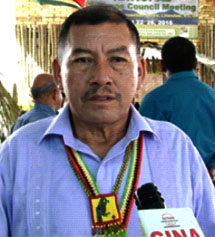The APNU+AFC Government has budgeted for the titling of 30 more indigenous communities even as it negotiates a four-year extension of the present project funded through the Guyana REDD+ Investment Fund (GRIF) and which ends in October 2016.
This was disclosed by the Minister of Indigenous Peoples’ Affairs Sydney Allicock in an interview with the Government Information Agency (GINA).
“In the 2017 budget we have budgeted for that period. If we don’t get the funding needed, we would have enough funding (from 2017) to hopefully do another 30 communities for 2017”, GINA quoted the minister as saying. Once the money is sourced, Allicock said that it will be used to acquire aerial videography services which will quicken the demarcation of boundaries in the communities.
GINA said that Black Field Survey Area Incorporated has made a proposal for a 50 percent discount to the Government for conducting the land survey for the demarcation project. The offer was made at the recently concluded National Toshaos Council meeting. The proposal is one that the Minister sees as feasible since it will speed up the demarcation process, GINA said.

According to Allicock, the company did a survey in St. Cuthbert’s Mission and was able to collect findings within four days. “This will help us in the areas of overlapping communities or if there is doubt where miners are concerned, if they are intruding, that sort of technology with, the drone, it will show you what is happening,” Allicock said.
Allicock stated, “This will complement what the surveyors are doing. It would be easier for them to now go on the ground to have their GPS reading, and put their plots or reference points.”
On Saturday, GINA said that 10 indigenous communities received land titles from President David Granger.
The US$10.7M land titling project seeks to enable Indigenous people to secure their lands and natural resources with a view towards sustainable social and economic development. Just months before it is scheduled to end, the Amerindian Land Titling (ALT) project has managed to demarcate only a quarter of the 68 villages it was supposed to complete.
The project began in October 2013 under the former PPP/C administration and is due to end in October 2016. It is being funded by money earned under Guyana’s forest protection partnership with Norway.
Appearing on August 3rd before the Parliamentary Sectoral Committee on Natural Resources, Allicock acknowledged that the project is behind in achieving its goals.
Head of the project Enrique Monize told the committee that under the ALT, 68 villages and communities were slated for attention. The project seeks to have land titles issued and the demarcation process completed for all Amerindian villages that submit requests, including those that request extensions; increase use of existing and alternative mechanisms to resolve land titling disputes; and produce a communication strategy including a handbook describing the process of titling, demarcation and the social and economic impacts of secure land tenure.
“…it is far from completion with only about a quarter of the estimated 68 villages being demarcated so far,” Monize told the committee. He said of the 68 villages slated for attention, 32 consist of villages that were previously demarcated and titled and are now seeking extension while 13 are communities that have been occupying State land and are now seeking titles so as to become established villages.
“All of these 45 villages will have to receive absolute grants for the lands requested. This will be followed by the demarcation process before each receive certificate of title through the land registry,” he said.
Monize added that of the remaining 23 villages, three are titled villages that received absolute grants prior to the project for extensions and are now slated for demarcation only. The remaining villages have received absolute grants at various times dating back from 1976 to the period just prior to the project. These are all scheduled for demarcation and titling only, he said.





